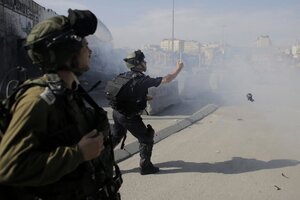Jerusalem lurches towards open conflict over Temple Mount
An assassination attempt of a rabbi, a provocative visit by an Israeli MP, and a Palestinian leader saying Israeli moves are tantamount to a "declaration of war" have Jerusalem at its most perilous moment since the end of the second intifada.

An Israeli border policemen lobs a stun grenade towards Palestinians protesting at Israel's Qalandia checkpoint in the West Bank today. The protest was over recent Israeli restrictions on access to Al Aqsa Mosque in Jerusalem.
Ammar Awad/Reuters
Jerusalem
Today Moshe Feiglin walked on the holiest site in Judaism and posed for photos in front of the Dome of the Rock, a revered Muslim shrine that rests where many believe the Jewish Temple once stood. In doing so the Israeli member of parliament fueled growing Muslim-Jewish tensions around Jerusalem's Temple Mount, which in the past week saw an assassination attempt against a right-wing rabbi and Palestinian leader Mahmoud Abbas call Israel's decision to temporarily close the site a "declaration of war."
Mr. Feiglin's action was a direct challenge to Prime Minister Benjamin Netanyahu’s call this morning for parliament to exercise “responsibility and restraint" around the Temple Mount complex.
“The Temple Mount is the most sensitive kilometer on earth,” Mr. Netanyahu said, as tensions in Jerusalem reached an intensity not seen in a decade. “It is easy to start a religious fire, but much more difficult to extinguish it.”
Feiglin, like Yehuda Glick, the rabbi currently recovering from the murder attempt last week, favors building Judaism's Third Temple on the site, which would require the destruction of both the Dome of the Rock and, many Muslims believe, the nearby Al Aqsa mosque.
Many Muslims say that a prayer at Al Aqsa, situated on a grand plateau overlooking Jerusalem, is worth 500 prayers elsewhere. By the same token, a match lit here can start a far bigger fire than if it were struck in almost any other hotspot of the Israeli-Palestinian conflict. The fire danger on the Temple Mount, or Haram al-Sharif, is arguably at its highest point since the second intifada.
That intifada, or uprising, broke out in the wake of a September 2000 visit to the Temple Mount by then Israeli opposition leader Ariel Sharon, who was escorted by 1,000 Israeli policemen. While he and even some Palestinian politicians later claimed that an intifada had been planned for months, the visit provided a rallying point for Palestinians.
For both Israelis and Palestinians, this compound is not only a sacred space but the front-line of their battle for sovereignty over Jerusalem.
In recent years there has been a significant uptick in Jewish visits, led by lawmakers like Feiglin and activists like Mr. Glick. The attack on Glick came after particularly heated clashes during the Jewish holidays last month. Masked protesters inside Al Aqsa, equipped with rocks and fireworks, battled Israeli police just outside the mosque, who responded with stun grenades. Israeli officials allege the violence is being organized by Hamas and other Islamist groups.
Many Palestinians and Muslims see visits such as Feiglin’s and Glick’s as highly provocative and a threat to a status quo that has prevailed since 1967, whereby the site is administered by Muslim authorities but security is provided by Israeli police.
This morning Netanyahu spokesman Mark Regev dismissed concerns that Israeli religious leaders will be given control over the site as “ridiculous” and insisted that the status quo would be “scrupulously” upheld.
But Feiglin's visit still poses a quandary for the prime minister. For in this conflict, words alone are enough to ignite war.

